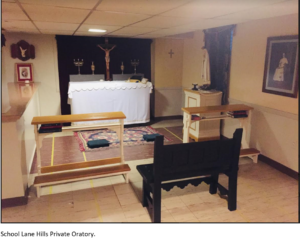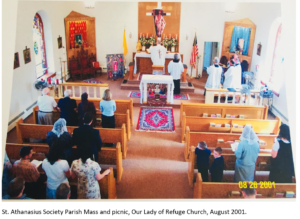Brief History of the Genesis of the Latin Mass and the St. Athanasius Society in Lancaster
by Dr. Robert Carballo
The present-day success story of Catholic tradition in the Lancaster area, with a thriving congregation loyal to the immemorial Mass and sacraments at St. Joseph Catholic Church, Cabbage Hill, had a very modest beginning indeed prior to its formalization by the Harrisburg Diocese at St. Anthony’s parish a little over a decade ago. Yet, given the historically slow, gradual development of movements and initiatives in the 2,000-year history of the Catholic Church, two decades is not really a very long time.
It was shortly after the beginning of this century that a letter to the editor of The New Oxford Review—a journal published by Dale Vree and a group of Anglican converts to Catholicism—triggered what would become the traditional apostolate in Lancaster. Such are the wonderful and mysterious workings of God’s inscrutable Providence.
In response to that letter, Erick Wittemann took the initiative in contacting me, noticing that I wrote from Lancaster and sensing I shared his interest in preserving Catholic tradition. Together, we explored how to best serve the Church by fostering her immemorial liturgical traditions. This was to be, initially, a purely lay endeavor.
The first step in this effort was the recitation on first Fridays of Our Lady’s rosary, led and attended by a hand-full of area Catholics in the School Lane Hills neighborhood, just west of Lancaster City. Those attending the first few months were no more than seven or eight persons: Erick Wittemann (Willow Street), the late Ray Anater (Akron), Tom Smith (York), the late Claire Lombard (Columbia), Juan Gonzalez (Lancaster), David Romeo (Lancaster), Jack Ferguson (Maytown), the late Jefrey Jamouneau (Harrisburg), and Robert Carballo (Lancaster). On occasion, the “small band of brothers,” in Shakespeare’s felicitous phrase, would be graced with the visit of a priest—such as Father Glenn Hartman, now at Mater Ecclesiae Chapel, East Berlin, N. J.
With time, the group had the blessing of spiritual direction from the late Father John Campion, an old and venerable priest then in charge of the remote country mission of Our Lady of Refuge in Doylesburg, Franklin County, Pennsylvania. Father Campion, a man in his eighties then and a family descendant of the famous English Reformation martyr and priest-scholar St. Edmund Campion, drove the approximately one-hundred miles (one way) to guide our rosary, give short spiritual conferences and offer the traditional mass. With his assistance, the humble apostolate acquired a new and more expansive dimension.
The first Friday masses started in the basement oratory (arranged specifically for this purpose) of my home where the rosary had been prayed for about a year. The oratory was appointed as decorously as circumstances allowed to make it worthy for the celebration of the immemorial liturgy of the Church’s Latin rite. Eventually—music being the most indispensable of the arts for liturgical celebration according to the Church’s tradition—the Gregorian chant choir, Te Deum Laudamus Schola, ably led and trained by Philip Crnkovich, was invited to sing at the masses, thus adding to the beauty and prayerfulness of our worship. Hence, on many Fridays we could count on the well-trained, professional schola to provide Gregorian chant and sacred polyphony in addition to classical hymnody, the men in cassock and surplice as is the tradition of the Church in her concern to add dignity and solemnity to her worship. At this time attendance grew to about twenty or twenty-five—and the basement oratory began to feel, happily, a bit crowded. It should be noted that some present-day parishioners of the Latin Mass congregation at St. Joseph’s—like Mr. and Mrs. John DeMarco of Lancaster and, occasionally, Judith Boutin of Camp Hill—started attending the first Friday masses.
At this point, the lay leadership, with Father Campion’s guidance, formed the Saint Athanasius Society in 2000 as an informal pious union of the Faithful (a structure allowed by Canon Law 298). The purpose of the Society was to attain a more structured and visible presence, as well as to petition the Bishop of Harrisburg for a regular Sunday Mass in the near future. The Society also began efforts to contact other priests to come to Lancaster to offer the Mass, with the dual purpose of ocassionally relieving Father Campion from his long drive and to provide for the future. A few priests came—some only once—among them Father Richard Munkelt, PhD, today a professor at Sacred Heart University in Connecticut, and Father Philip Stark, MA, now a chaplain for the Slaves of the Immaculate Heart of Mary in Still River, Massachusetts. It should be added that this apostolate would have been much more difficult, if not impossible, without the wise advice and practical aid provided by two veteran champions of Catholic Tradition, both now deceased: Mr. Bob Charleton, early and indefatigable leader of the St. Lawrence community, Harrisburg, before and after it came to its beautiful present home, and Mr. Conde McGinley of Parkesburg. May God reward richly these two soldiers of the Immemorial Faith.
The St. Athanasius Society, from its inception at the first Friday rosary, accomplished (though not without some interruptions) what it set out to do: build a base for Catholic Tradition in the Lancaster area. Many prayed, worked, wrote, and, above all, responded to God’s graces in this hour of need of Holy Mother Church. All the work, petitions, and difficulties would eventually lead to the positive action of Bishop Kevin Rhoades, Ordinary of Harrisburg, in establishing a permanent traditional apostolate at St. Anthony’s Catholic Church, Lancaster, in May 2008 under the papal provision of Benedict XVI’s motu propio, Summorum Pontificum. The genesis and growth of the traditional apostolate in Lancaster prove, once more, the old adage that “with God all things are possible.” Deo gratias!

